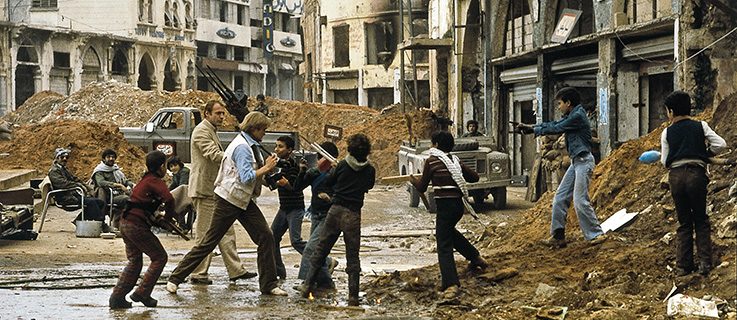Traces of Germany in Lebanon
“Die Fälschung” / “Circle of Deceit” – Film and Reality Blend Together in Beirut

In 1980, the German director Volker Schlöndorff was at a crossroads: he had just become the first German to win an ‘Oscar’ for ‘Best Foreign Language Film’ for his Bertolt Brecht adaptation “The Tin Drum” and a successful career in Hollywood awaited him. But, as he remembers, this would have meant an end to his freedom. To break out of the Hollywood system, and perhaps to reassure himself of his own freedom, the German director chose a subject that seemed completely at odds with Hollywood.
Schlöndorff adapted the novel “Die Fälschung” (“Circle of Deceit”) by Nicolas Born about the war correspondent Georg Laschen who flees from his marital problems to Beirut to report on the civil war raging there. But the backdrop for the film wasn’t built on a sound stage, but was provided by the civil war itself: Schlöndorff shot his film in the middle of the still heavily contested, but already completely devastated city centre of Beirut.
Before the civil war broke out in 1975 and wrought havoc on Lebanon for fifteen years, Beirut was regarded as the ‘Paris of the East’ and together with Cairo was the capital of Arabic film. Five years after the start of the war, Schlöndorff began shooting his film. He had succeeded in casting Bruno Ganz in the role of the reporter Laschen, who increasingly begins to doubt his own job, and Hannah Schygulla in the role of the German Embassy employee Arianna Nassar. Their first scene together was set in the German Embassy – but it was shot in the Goethe-Institut building in West Beirut.
Schlöndorff saw himself in the tradition of the Italian director Roberto Rossellini, who used the completely bombed-out city of Berlin as the setting for his film “Germany, Year Zero”. The difference was that the war in Beirut was still ongoing. In order to even be able to film in the city centre, the director met with all the warring parties and negotiated an ‘artistic ceasefire’, but even so, he still had to be careful. At times, film and reality blended together: while shooting in the ruins of the old town, Bruno Ganz didn’t just have to focus on the script, but also had to make sure to crouch when passing through intersecting roads so he wouldn’t get hit by snipers. Children who saw plastic body parts lying around on set brought real human remains as props the following day. In the weeks after shooting, Hannah Schygulla travelled through Lebanon for four weeks looking for an orphan to adopt – just like Arianna, her character in the film. Not a single blank was fired during the entire shooting. The Lebanese extras who were cast every morning in Beirut insisted on real ammunition, and some of them were also among the ranks of various militia factions at nighttime.
Schlöndorff’s work, while hardly sparing in pyrotechnics and extra explosions, still paints a realistic picture of how Beirut looked during the civil war. For “Circle of Deceit”, he let smoke rise again from the completely destroyed Holiday Inn, which was heavily embattled during the so-called ‘Battle of Hotels’ from 1975-1976 and is still regarded as a symbol of the civil war. The inner city shown in the film has since been torn down and reconstructed as a luxurious ‘downtown’. Although the film tells a fictional tale, it very impressively portrays the violence perpetrated by the militias as a part of everyday life. The reason the militias even agreed to an ‘artistic ceasefire’, which made filming possible in the first place, was that the all the militias saw it as a chance for positive coverage of their group. Whether the production of Schlöndorff’s media critical film is ethically justified is something every viewer has to decide for themselves.
Anyone watching “Circle of Deceit” shortly after its release in the 1980s and hoping the civil war would end soon was to be bitterly disappointed. Because just like the title of the film, the ‘artistic ceasefire’ was little more than a deceit. As soon as the shooting wrapped up in 1981, the conflicts erupted again, the ceasefire was called off and the militias returned to their daily business. The director only had small comfort to offer: “The film is over, reality continues.” None of the ceasefires during the next ten years lasted. It wasn’t until 1990 that an enduring peace agreement was reached.